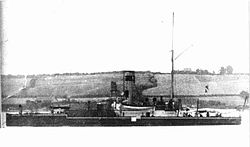Mosquito (ship)
|
The type ship wasp
|
||||||||||||||||||||||
|
||||||||||||||||||||||
|
||||||||||||||||||||||
|
||||||||||||||||||||||
|
||||||||||||||||||||||
The Mücke was the fourth ship in the Wespe class , a class of eleven armored cannon boats of the Imperial Navy , which was constructed for the defense of the German North and Baltic Sea coasts.
Construction and service time
The mosquito was like her sister ships and from the Bremen shipyard AG Weser built. Work on the ship began in 1876. The intended use of armor from German production was not yet possible for her, as was the case with the three previous units, as the Dillinger Hütte commissioned with the production was not yet able to guarantee the required quality of the armor plates. Material from British manufacture had to be used. The ship with the household name Neubau Panzerfahrzeug D was launched on May 5, 1877.
After the completion of the ship, it was not until May 1, 1885 that the mosquito was put into service for the first time. After the training of crews for her sister ships and individual exercises the ship took in the fall as a flagship one from Salamander , Viper and wasp formed Division at the autumn maneuvers of the fleet in part, with an attack on the Jademündung was simulated. While the other three units were decommissioned, the Mücke remained in active use as the parent ship of the North Sea Reserve Division.
On May 11, 1886, a flotilla consisting of viper , salamander and camaeleon was formed, the flagship of which was again the mosquito . After their dissolution, the ship undertook individual exercises in order to take part in maneuvers of the fleet in July and August. In 1887, the flotilla met again on August 15th in the same composition as in the previous year. Again as part of a practice attack on the Jade estuary, the association took part in the autumn maneuvers.
The mosquito remained in service for the following four years , although its use hardly differed from that of 1887. It was not taken out of service for the first time on September 24, 1891, in order to be overhauled and slightly modified in the Kaiserliche Werft Wilhelmshaven . It received an armored command tower and reinforced armament.
On April 23, 1895, the Mücke was put back into service and relocated to Danzig , where it replaced the Crocodill as the parent ship of the Armored Cannon Boat Reserve Division. In 1895 and 1896 the ship undertook exercises together with the Natter in the Baltic Sea and briefly in the North Sea . On August 3, 1897, the entire division, to which Crocodill and Scorpion still belonged, was activated to take part in the autumn maneuvers of the fleet after unit exercises, which again undertook a training attack on the Jade Estuary. The same took place in 1898, but only mosquitoes and snakes took part in the exercises that year. On October 1, 1898, the ship's second period of service was finally over.
The dispatch of ships of the line of the Brandenburg class due to the unrest in China led to a shortage of operational warships at home in 1900. This brought the mosquito one last active activity from July 27th, which lasted until September 24th, 1900. This made her the longest-serving ship in her class.
Whereabouts
In the following years the mosquito was used for leak tests, and after it was deleted from the list of warships on March 18, 1911, it was converted to a heating ship and used in both functions in Wilhelmshaven until 1918. On June 25, 1921, it was finally sold for 100,000 marks and then broken up in Wewelsfleth .
The ship's bell of the mosquito is used today at the Hanseatic Yacht School of the German High Seas Sports Association HANSA for the morning glass at the start of school operations.
Commanders
| May 1 to September 1885 | Captain Kohlhauser |
| September 29, 1885 to March 27, 1888 | Lieutenant captain / Corvette captain Richard Hornung |
| April 1888 to January 1889 | Corvette Captain Alfred Herz |
| January to August 1889 | Corvette Captain Oscar von Schuckmann |
| August to September 1889 | Captain Paul Walther |
| September 1889 to September 1890 | Corvette captain / sea captain Oscar von Schuckmann |
| October 1890 to August 1891 | Corvette Captain Alfred Gruner |
| August 24th to September 24th, 1891 | Oberleutnant zur See Max Wilken |
| April 23 to May 1895 | unknown |
| May 1895 to September 1896 | Corvette Captain Wittmer |
| September 1896 to October 1897 | Corvette Captain Adolf Paschen |
| October 1897 to October 1, 1898 | Corvette Captain Deubel |
| July 27 to September 24, 1900 | Corvette Captain Roar |
literature
- Gröner, Erich / Dieter Jung / Martin Maass: The German warships 1815-1945 . tape 1 : Armored ships, ships of the line, battleships, aircraft carriers, cruisers, gunboats . Bernard & Graefe Verlag, Munich 1982, ISBN 3-7637-4800-8 , p. 164 f .
- Hildebrand, Hans H. / Albert Röhr / Hans-Otto Steinmetz: The German warships . Biographies - a mirror of naval history from 1815 to the present . tape 6 : Ship biographies from Lützow to Prussia . Mundus Verlag, Ratingen, S. 121 f . (Approved licensed edition by Koehler's Verlagsgesellschaft Hamburg, approx. 1990).
